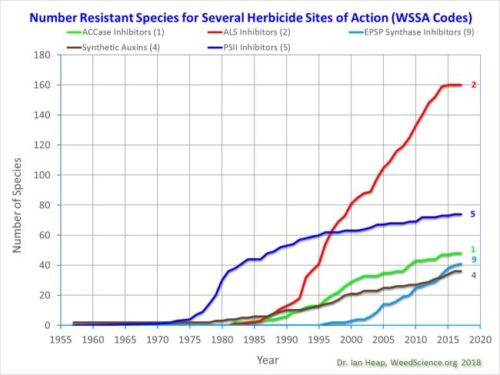Week killers do their job but also cause problems: illness among people exposed to them (especially farm workers), induction of resistance, and killing weeds in places they are not supposed to be.
Illnesses: The most well known is the non-Hodgkins lymphoma associated with use of glyphosate (Roundup).
Weed resistance: This chart from the University of Minnesota shows the number of species resistant to various kinds of herbicides from 1955 to 2020. GMO crops resistant to glyphosate were first approved in 1994.

Herbicide drift: This has been a particular problem with the weed killer dicamba used with GMO corn and soybeans. It has a particular problem: it drifts, and does so inconveniently over organically produced crops that are not weed resistant, thereby killing them and making organic farmers extremely unhappy but without recourse, apparently.
Now an investigative report from In These Times demonstrates how Monsanto and BASF, the makers of dicamba, knew perfectly well that it drifted and would cause extensive damage, but sold it anyway.
Executives from Monsanto and BASF, a German chemical company that worked with Monsanto to launch the system, knew their dicamba weed killers would cause large-scale damage to fields across the United States but decided to push them on unsuspecting farmers anyway, in a bid to corner the soybean and cotton markets.
The investigation found:
- [Monsanto’s] own research showed dicamba mixed with other herbicides was more likely to cause damage. The company also prevented independent scientists from conducting their own tests and declined to pay for studies that would potentially give them more information about dicamba’s real-world impact.
- Although advertised as helping out customers, the companies’ investigations of drift incidents were designed to limit their liability, find other reasons for the damage and never end with payouts to farmers. For example, BASF told pesticide applicators that sometimes it is not safe to spray even if following the label to the letter, placing liability squarely on the applicators.
As for recourse:
A federal court banned the herbicide earlier this year, but the EPA reinstated dicamba for five more years in October.
Earlier this year, a federal jury sided with a Missouri peach farmer who sued the companies for driving his orchard out of business. The jury awarded Bill Bader $15 million for his losses and $250 million in punitive damages designed to punish Bayer. Bayer and BASF are appealing the verdict. The punitive damages were later reduced to $60 million.
This report is well worth reading for its detailed review of documents. These demonstrate that Monsanto and BASF could not have cared less about the damage their herbicide might cause. Monsanto has been purchased by Bayer, which defends its purchase to the hilt.
Bayer’s stock prices declined dramatically after the Monsanto purchase. It’s hard to feel sorry for either company.



